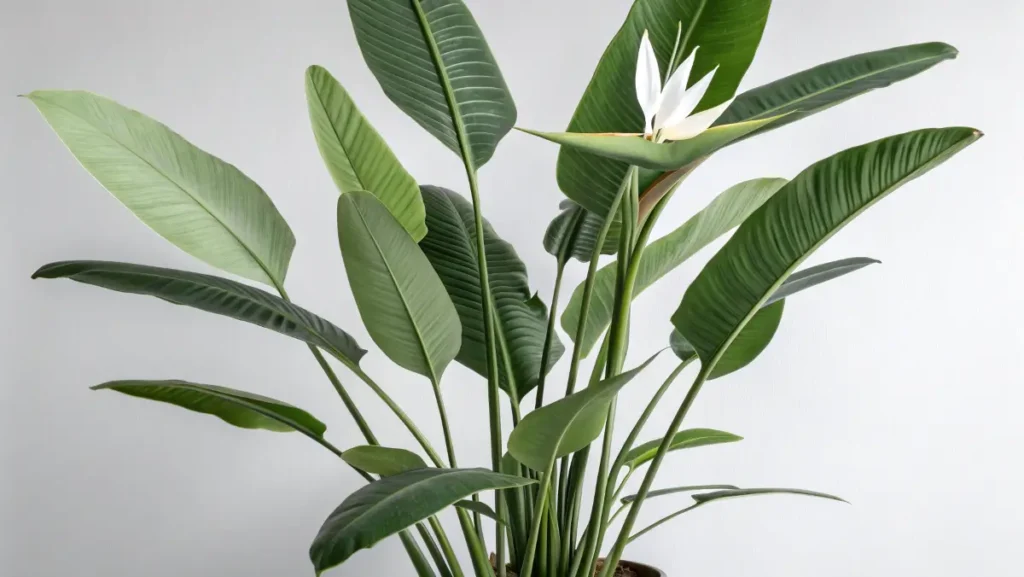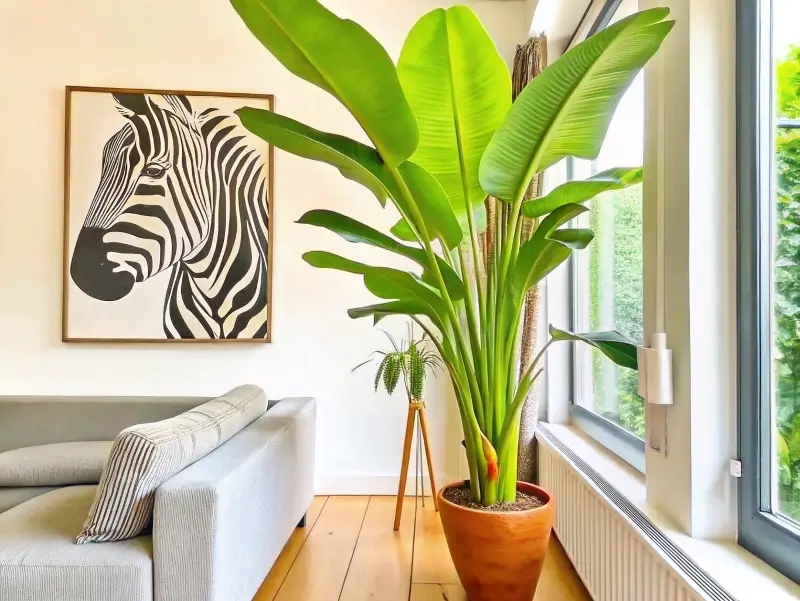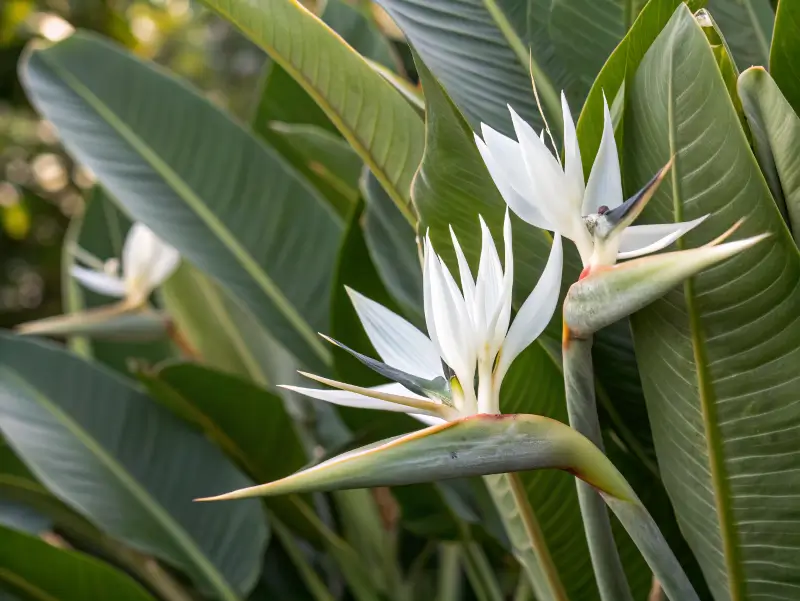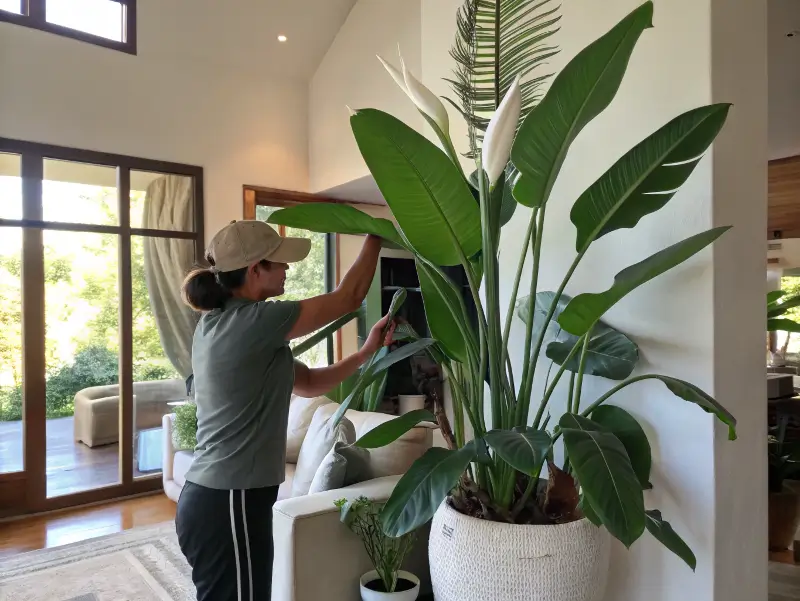
I’m super excited to chat with you about the white bird of paradise plant. In this article, I’ll share tips and tricks so you can keep yours happy and healthy. We’ll talk about its background, growing conditions, watering needs, and even deal with pests. You’ll see that caring for one doesn’t have to be complicated. We’ll also compare it to other Bird of Paradise varieties, mention different ways to style your indoor or outdoor space, and cover some common FAQs. If you’ve ever been curious about how to handle a large bird of paradise at home, keep reading—there’s loads of info coming your way!
Table of Contents
Introduction to the White Bird of Paradise Plant
Defining the White Bird of Paradise
I remember the first time I encountered a white bird of paradise plant. It looked like something straight from a tropical dream, with broad leaves and a striking white bloom. Unlike the orange-flowering types, the bird of paradise white variety gives off a more subtle vibe, reminding me of clean lines and breezy beach houses. When folks mention “giant leaf tropical plants,” this beauty definitely comes to mind.
Scientific Classification and Origins
The fancy name is Strelitzia nicolai. It comes from southern Africa, where you’ll often find it growing wild in sunny spots. Because it’s native to warmer regions, it’s not big on freezing temps. However, many indoor gardeners have found that with a few helpful tweaks, it can thrive inside too.
Popularity in Home Gardening
You’ll see the large bird of paradise in homes all over social media. People love its big fan-like leaves, which can liven up any living room corner. And honestly, who wouldn’t want a white bird of paradise flower peeking out once the plant matures?
Understanding the Botanical Background
Strelitzia Nicolai vs. Strelitzia Reginae
You might hear folks confuse the white bird of paradise plant (Strelitzia nicolai) with Strelitzia reginae, which has orange petals. In my experience, they’re like cousins sharing certain features, yet they differ in color and size. The nicolai variety grows larger, has white blooms, and is often called the giant white bird of paradise plant. Meanwhile, the reginae is smaller and boasts vivid hues.
Growth Patterns and Flower Morphology
I’ve noticed that the white bird of paradise plant grows upright with leaves that fan out, giving it a statuesque look. The blooms form near the top, sporting that signature boat shape. If you spy a white bird of paradise flower, consider yourself lucky because they can be slow to produce when grown indoors.
White Bird of Paradise in Its Native Habitat
In wild settings, the bird of paradise plant white variety can soar to impressive heights, sometimes topping 20 feet. The roomy outdoor environment allows roots to stretch, and the sun exposure boosts growth rates. I think it’s pretty neat that these plants, which can look delicate, handle sunny climates without much fuss.
Ideal Growing Conditions for White Bird of Paradise Plant

Sunlight Requirements and Placement
If there’s one thing I’ve learned, it’s that a white bird of paradise plant craves bright light! I like placing mine near a sunny window. Yes, white bird of paradise plant care involves a good amount of light, but that doesn’t mean it always needs harsh direct sun in the middle of summer. Morning or late afternoon sun is my favorite choice, especially if you live somewhere scorching hot.
Best Soil Mixes for Healthy Growth
A quick tip: pick a well-draining mix that doesn’t hold onto water for too long. My go-to potting combination usually includes peat-based soil and some perlite or pumice. This way, the roots won’t sit in water, which reduces the risk of root rot.
Temperature and Humidity Considerations
The large bird of paradise thrives best in temps above 65°F. Also, moderate humidity levels are awesome, though it tolerates typical indoor conditions well.(For more official temperature and planting nuances, you can check resources from the United States Department of Agriculture. It’s quite handy!)
Watering and Fertilizing Your White Bird of Paradise
Proper Watering Schedule to Avoid Root Rot
I keep a simple rule: let the top inch or two of soil dry out before watering again. This works wonderfully for the white bird of paradise plant that I have in my living room. Overwatering is one of the biggest hazards, in my opinion.
Fertilizer Types and Methods
During spring and summer, I use a balanced fertilizer about once a month. It helps promote strong foliage, and if you’re lucky, might encourage a white bird of paradise flower. Fast-draining soil plus moderate feeding is often the sweet spot for these beauties.
Signs of Overwatering or Nutrient Deficiency
Late last year, I noticed yellowing leaves and realized I’d been a bit too generous with water. Brown leaf tips can indicate dryness, but yellowing often suggests either too much water or a missing nutrient. Keep an eye out for these signs to keep your plant in tip-top shape.
Caring for Indoor vs. Outdoor White Bird of Paradise Plant

Pros and Cons of Indoor Cultivation
I love having an indoor bird of paradise plant white because it adds an exotic vibe to my living space. The pros? You get to see it every day, it cleans up the air (it’s said to help filter some toxins), and it brings a tropical aura even if you’re somewhere cold. The cons? Limited sunlight might slow down its growth. Also, you might need to dust those big leaves more often, since indoor air can carry dust particles that settle on them.
Adapting the Plant to Outdoor Environments
If you want to move your white bird of paradise plant outdoors, do it gradually. I once popped a pot straight out in full sun, and the leaves scalded. So, move it a little at a time, letting the plant adjust to higher light. Keep an eye on watering needs too, since outside heat can dry things out faster.
Transitioning from Indoor to Outdoor & Vice Versa
If winter temperatures dip, bring your giant white bird of paradise plant back indoors. A short session in the fresh air can help your plant, but watch for pests. I’ve had spider mites hitch a ride inside, so inspect the foliage or wipe it down before any big move.
Propagation Techniques and Pruning Tips
Propagation by Division
One of the simplest ways to get new white bird of paradise plant babies is by division. Carefully separate a clump of rhizomes near the base. I like to do this in the early growing season when the plant is more receptive to any root disturbance.
Rooting Offshoots for New Growth
Sometimes, you might see small offshoots next to the mother plant. Gently free these “pups” and pot them. Think of it like introducing them to their new apartment. Give them well-draining soil and keep them in bright light.
When and How to Prune Safely
I only prune if I see dead or damaged leaves. Pruning away old leaves lets the new growth shine. Just be mindful: extra pruning won’t magically push out a white bird of paradise flower, since that depends on maturity and proper care. By the way, if you’re a fan of unique houseplants, you should also check out Anthurium Crystallinum. It’s a gorgeous plant known for its velvety leaves—just saying!
Common Pests and Diseases

Identifying Mealybugs, Spider Mites, and More
None of us like pests. I mainly see spider mites or mealybugs on my white bird of paradise plant. They show up as tiny specks or white, cotton-like clusters. Keep your eyes peeled because they can multiply fast.
Best Treatment and Prevention Methods
If you catch pests early, a simple wash with soapy water can help. In more widespread infestations, insecticidal soap is your friend. Prevent issues by wiping leaves regularly. That’s one reason I dust my large bird of paradise—it’s not just for good looks!
Maintaining Overall Plant Health
Healthy plants are less likely to be hit hard by pests or diseases. Make sure you have adequate air circulation, sunlight, and water management. Avoid soggy soil, because stagnating moisture can attract fungus or gnats. Honestly, just keep an eye on those leaves—if they start turning strange colors or get spots, hop to it and investigate.
Differences Between Bird of Paradise and White Bird of Paradise Plant
Variations in Flower Color and Size
When we say “Bird of Paradise,” some folks think of the vibrant orange blooms. However, the bird of paradise white type stands out with that cool, white hue. In size, the white bird of paradise plant can shoot up taller, making it an exciting choice for anyone wanting a statement piece.
Leaf Structure and Growth Habits
I see that the white bird of paradise plant generally develops wider leaves that may split over time in windy situations. The orange variety has a more upright look. Both belong to the same plant family, but the white version often has that trunk-like structure forming near the base as it grows older.
Aesthetic Appeal in Landscaping
For a big, bold outdoor design, many landscapers go with the giant white bird of paradise plant. It pairs well with other tropicals, forming a lush vibe. By contrast, the smaller, orange variety works well in decorative pots.
Styling, Decorating, and Landscaping with White Bird of Paradise Plant
H3: Placing Indoors for a Tropical Touch
I’ve placed a white bird of paradise plant in my entryway before, and everyone who walked in got that “beach vacation” vibe. It can be a showstopper if you give it a nice pot, maybe something modern or even a faux stone container. Another friend of mine arranged a few companion plants nearby, like the Pinky Plant that adds a pop of pink foliage, making the room look so lively. Together, they create an awesome color contrast.
Outdoor Landscape Design Ideas
In mild climates, you can create a tropical corner with the white bird of paradise plant, some palms, and bright flowers. The large bird of paradise can form a privacy screen if you group a few together. I once saw a backyard design with stepping stones and a cluster of these majestic plants near a pool. Talk about serious style points.
Pairing with Complementary Plants and Foliage
When landscaping outside, consider hardy companions like ferns or smaller palm varieties. If you’re going for an exotic look, place a mix of bright blossoms like hibiscus or even short succulents. The wide leaves of a bird of paradise plant white pair nicely with slender shapes or trailing vines, adding visual drama.
Frequently Asked Questions
How to Care for Bird of Paradise?
The key is bright light, moderate watering, and occasional feeding. Whether it’s the orange or white bird of paradise plant care, the basics remain similar. Give them a roomy pot and don’t drown the roots.
Are White Birds of Paradise Rare?
I’ve found that the white bird of paradise plant is not exactly rare, but you might not see it in every garden center. Online nurseries often carry it, so it’s easier to find these days.
Can White Bird of Paradise Take Full Sun?
Yes, they love the sun! However, if you’re moving it outside from indoors, introduce it to direct light gradually. Too much direct light suddenly can scorch those pretty leaves.
What Is the Difference Between a Bird of Paradise and a White Bird of Paradise?
The main difference is color and size. The white version grows taller and has white petals, whereas the standard Bird of Paradise has flashy orange blooms.
Conclusion and Final Thoughts
Summarizing Key Insights
If you’re as captivated as I am by the white bird of paradise plant, I hope all these pointers help. Bright light, sensible watering, and periodic feeding are essential. Keep an eye out for pests, and don’t hesitate to relocate your plant if it’s struggling.
Encouraging Responsible Plant Care
Remember, caring for a great houseplant is about balance and observation. If your bird of paradise white seems off, look at its leaves, check the roots, and adapt your routine. Don’t be afraid to try new spots in your home. With the right approach, your large bird of paradise should thrive for years to come.
